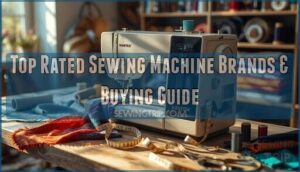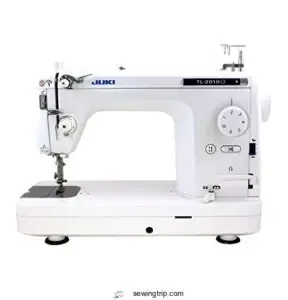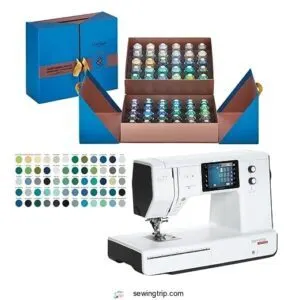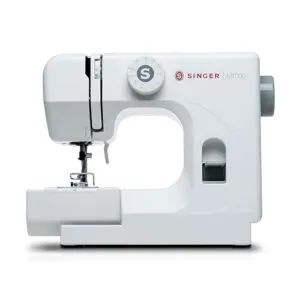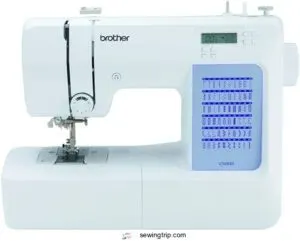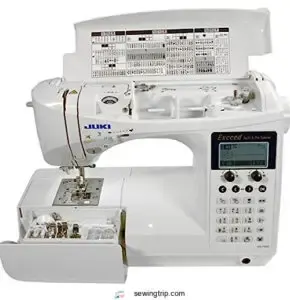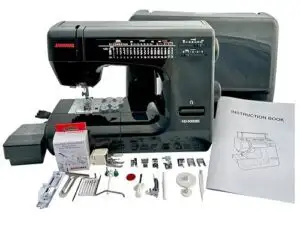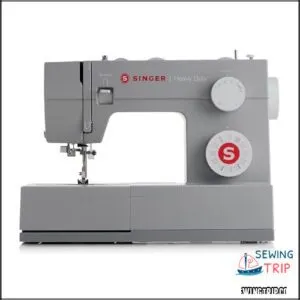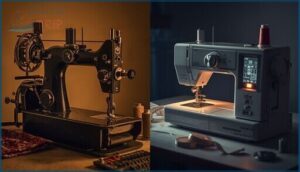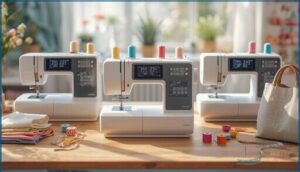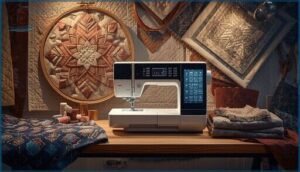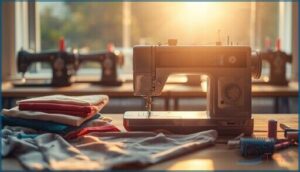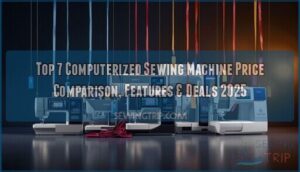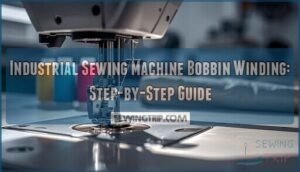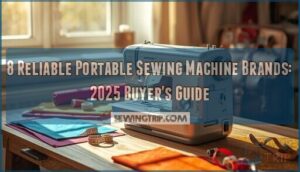This site is supported by our readers. We may earn a commission, at no cost to you, if you purchase through links.
Your first sewing machine purchase shouldn’t feel like decoding industrial equipment manuals. Yet walk into any fabric store, and you’ll face walls of machines—some promising 240 built-in stitches, others boasting metal frames that could survive a hurricane. The difference between a $150 beginner model and a $3,000 computerized marvel isn’t always clear until you’re three projects in and wrestling with thread tension.
Smart sewists know that brand reputation matters more than flashy feature lists. Singer’s 25-year warranties tell a different story than machines with 90-day coverage, and Juki’s 24-hour parts turnaround becomes critical when you’re racing a deadline.
The right brand match depends on whether you’re hemming curtains or tackling leather upholstery—and how much frustration you’re willing to tolerate when that bobbin jams at midnight.
Table Of Contents
- Key Takeaways
- Top 10 Rated Sewing Machine Brands
- 1. Singer Easy Sewing Machine Kit
- 2. Juki TL-2010Q Sewing Quilting Machine
- 3. Bernette B77 Sewing and Quilting Machine
- 4. Brother SE1900 Sewing Embroidery Machine
- 5. Brother GX37 Sewing Machine Value Pack
- 6. Singer M1000 Lightweight Sewing Machine
- 7. Brother CS5055 Computerized Sewing Machine
- 8. Juki Computerized Sewing Machine
- 9. Janome HD-5000 Black Edition Sewing Machine
- 10. Heavy Duty Sewing Machine
- Key Features of Leading Sewing Machine Brands
- Mechanical Vs. Computerized Sewing Machines
- Best Sewing Machine Brands for Beginners
- Top Sewing Machine Brands for Advanced Projects
- Comparing Sewing Machine Brand Reliability
- How to Choose The Right Sewing Machine Brand
- Frequently Asked Questions (FAQs)
- Conclusion
Key Takeaways
- Brand reputation and warranty coverage matter more than feature count—Singer and Janome’s 25-year warranties signal long-term reliability, while Juki’s 24-hour parts turnaround supports serious sewists who can’t afford downtime.
- Match your machine to actual project needs rather than aspirational ones—beginners waste money on 240-stitch computerized models when 20-60 stitches handle most garment construction, mending, and light quilting.
- Mechanical machines ($100-$250) outlast computerized models by decades and cost less to maintain, making them smarter investments for sewists who prioritize durability over automation and touchscreen controls.
- Heavy-duty construction with metal frames and powerful motors separates machines that handle thick fabrics like denim and leather from those that jam on anything beyond cotton—look for models rated 60% stronger than standard if you work with challenging materials.
Top 10 Rated Sewing Machine Brands
The sewing machine market is crowded with options, but the top brands keep rising to the top for good reason. We’ve narrowed down the best machines across different needs—whether you’re just starting out, tackling quilting projects, or looking for serious durability.
Here’s what we found works best.
1. Singer Easy Sewing Machine Kit
Singer’s Easy Sewing Machine Kit hits the sweet spot for beginners stepping into sewing. You get a mechanical machine with 97 stitch applications, a built-in needle threader that saves setup time, and a full metal frame for stability.
The kit bundles over 200 notions—threads, needles, scissors, storage tote—so you’re ready to start mending or crafting immediately.
With straightforward controls and a free arm for tricky seams, this beginner-friendly package won’t overwhelm you while you’re learning the fundamentals.
Best For: Anyone new to sewing who wants a complete, ready-to-use setup without spending a fortune or getting lost in complicated computerized features.
- 97 stitch options and a built-in needle threader mean less fiddling and more actual sewing time, even if you’re brand new to this.
- Over 200 included accessories—threads, needles, scissors, storage tote—let you jump straight into projects without buying extras piecemeal.
- Full metal frame and intuitive controls make the machine stable and straightforward to operate, so the learning curve stays manageable.
- Some users report the needle threader is finicky and harder to use than advertised, plus you don’t get a manual to troubleshoot when things go wrong.
- Front-loading bobbin installation trips up a few people, and thread breakage or jamming happens often enough that it’s worth knowing about upfront.
- This machine is built for basics and hobby projects—it won’t handle heavy-duty or commercial work, so don’t expect it to be a workhorse for intensive use.
2. Juki TL-2010Q Sewing Quilting Machine
Ready to step up your quilting game? The Juki TL-2010Q brings industrial construction to your home studio. This semi-industrial quilting machine hits 1,500 stitches per minute—nearly double what standard domestic machines deliver—so your piecing and quilting move fast without sacrificing quality.
Its aluminum die-cast body keeps vibration minimal and stitches consistent. You get high-speed quilting paired with ergonomic features like a knee lifter and automatic thread trimmer. With adjustable stitching controls and a 23-inch work area, it’s built for serious quilters tackling ambitious projects.
Best For: Serious quilters and home studio enthusiasts who want industrial-grade speed and precision without the price tag of a full long-arm machine.
- Blazing-fast 1,500 stitches per minute with variable speed control lets you piece and quilt roughly twice as fast as standard domestic machines while maintaining perfect stitch quality
- Aluminum die-cast construction keeps vibration down and delivers rock-solid, consistent stitches even during high-speed work on thick quilt sandwiches
- Hands-free knee lifter, automatic needle threader, and automatic thread trimmer combine to save you time and frustration so you can focus on your creative work
- Straight-stitch only means no decorative or zigzag options—this machine is laser-focused on quilting and piecing, so if you want versatility, look elsewhere
- The LED lighting is decent but some users find it not quite bright enough for detailed work and end up adding an external light source anyway
- No dedicated quarter-inch presser foot included, so you’ll need to buy that separately or spend time dialing in your seam allowance manually
3. Bernette B77 Sewing and Quilting Machine
If you want a machine that bridges the gap between budget and professional capability, the Bernette B77 deserves your attention. This computerized quilting machine offers over 500 stitches with 17 buttonhole styles, giving you serious design flexibility without the industrial price tag.
Its dual feed system manages everything from delicate silk to thick denim smoothly, while the five-inch touchscreen makes operation straightforward.
The stitch quality earns consistent praise from users, and the five-year mechanical warranty backs your investment. It’s positioned perfectly for intermediate sewists ready to upgrade.
Best For: Intermediate to experienced sewists who want professional-quality stitching, design versatility, and reliable performance without the premium price tag of high-end machines.
- Over 500 stitch options with 17 buttonhole styles give you serious creative flexibility for garments, quilts, and accessories
- Dual feed system handles everything from delicate silk to thick denim smoothly, with adjustable presser foot pressure for different fabrics
- Five-year mechanical warranty and five-inch touchscreen with built-in sewing consultant make this a solid long-term investment backed by support
- Some users report threading accuracy issues and stitches that aren’t always secure, requiring manual backstitching to reinforce seams
- Thread tension may need manual adjustment instead of being fully automatic, adding an extra step to setup
- Customer support can be slow to respond, and some users have experienced error messages and motor issues
4. Brother SE1900 Sewing Embroidery Machine
If you’re drawn to embroidery but want sewing versatility too, the Brother SE1900 splits the difference perfectly. This computerized sewing machine packs 240 stitches, 138 embroidery designs, and 11 fonts, giving your projects genuine range. The 5″ x 7″ embroidery field accommodates larger monograms and designs without compromise.
Its 3.2″ touchscreen makes navigation straightforward, while the USB port lets you import custom patterns. Speed reaches 850 stitches per minute for sewing and 650 for embroidery.
Users consistently rate it 4.7 out of 5 stars—92% would recommend it. The 25-year chassis warranty backs your investment.
Best For: Hobbyists and crafters who want both serious sewing capabilities and embroidery features without committing to two separate machines.
- Large 5″ x 7″ embroidery field and 240 sewing stitches give you plenty of design flexibility for everything from monogramming to quilting projects.
- Touchscreen interface and USB import make it easy to load custom designs and navigate—even beginners pick it up quickly, and 92% of users would recommend it.
- Strong warranty (25 years on chassis) and solid build quality back your investment at a mid-range price point.
- Can get loud during embroidery work, and the machine struggles with thick or heavy materials due to needle assembly limitations.
- Requires a separate extension table and spindle holder for large thread spools, adding extra costs beyond the initial purchase.
- There’s a learning curve for embroidery functions, especially if you’re new to the machine’s on-screen editing features.
5. Brother GX37 Sewing Machine Value Pack
The Brother GX37 hits the sweet spot for beginners who want genuine capability without complexity. This mechanical machine delivers 37 built-in stitches and an automatic needle threader that saves frustration.
Your value pack includes six presser feet, bobbins, needles, and a dust cover—everything you need straight out of the box. At $139.99, it’s affordable for entry-level sewists tackling everyday projects and light quilting.
The 25-year chassis warranty backs your investment, and customer ratings consistently land around 4.5 stars. It’s straightforward sewing made accessible.
Best For: Beginners and everyday sewists who want a straightforward machine with real capability at an affordable price.
- Automatic needle threader and drop-in bobbin system make setup and threading quick and frustration-free
- 37 built-in stitches cover garment construction, hemming, mending, and light decorative work with versatility for various projects
- Value pack includes six presser feet, bobbins, needles, and dust cover—everything you need to start sewing right away
- Not designed for heavy-duty work, thick materials, or industrial projects beyond light-to-medium fabrics
- LED light can feel dim during detailed work, and changing needles requires a screwdriver rather than quick-change convenience
- No included carrying case, though it fits standard universal cases, and the built-in storage compartment can be awkward to use
6. Singer M1000 Lightweight Sewing Machine
The Singer M1000 proves that portability benefits don’t mean sacrificing capability. This compact mending machine weighs just 5.5 pounds, making it your go-to for repairs on the move.
You’ll find 32 stitch options covering basics like straight, zigzag, and blind hem—plenty for beginners tackling everyday projects. The top drop-in bobbin threads easily, and the free arm manages cuffs and sleeves smoothly.
At $104.99, it’s the top-selling compact model, with strong customer ratings reflecting its beginner-friendly design. A 30-day warranty backs your purchase.
Best For: Beginners and hobbyists who need a lightweight, affordable sewing machine for mending, repairs, and small creative fabric projects.
- Weighs just 5.5 pounds with a compact design that’s easy to store and transport wherever you need it
- Offers 32 built-in stitches including straight, zigzag, and blind hem, giving you solid options for most basic sewing tasks
- Top-selling model at $104.99 with strong beginner-friendly ratings and a 30-day warranty for peace of mind
- Not designed for thick or heavy fabrics—it struggles with dense materials and heavy-duty projects
- Limited speed control and may feel slow compared to more powerful machines, which can be frustrating for faster work
- Some users report durability concerns and find the customer support and warranty repair process frustrating and inconvenient
7. Brother CS5055 Computerized Sewing Machine
Computerized precision meets beginner-friendly simplicity with the Brother CS5055. This workhorse delivers 60 built-in stitches—utility, decorative, and heirloom styles—all accessible via an easy-to-use LCD display. Seven presser feet handle everything from buttonholes to zippers.
The metal frame and fixed needle bar keep everything stable, while automatic needle threading cuts setup time drastically. Its 7-point feed-dog system powers through denim and tweed smoothly, making fabric handling simple for everyday projects.
At mid-range pricing, you’re getting sophisticated features without the premium cost.
Best For: Beginners and intermediate sewers who want a reliable, easy-to-use machine for garments, alterations, and light quilting without spending a fortune.
- 60 built-in stitches with LCD display make it easy to tackle everything from basic repairs to decorative projects
- Metal frame and automatic needle threading deliver stability and fast setup that saves time and frustration
- 7-point feed system handles thick fabrics like denim smoothly, plus you get 7 presser feet right in the box
- Not built for heavy-duty or industrial work—struggles with very thick layers or professional-grade projects
- Some users report thread pulling out of the needle eye and occasional bobbin tangles if threading isn’t precise
- Lightweight design can shift around on the table during use, and the foot pedal lacks fine speed control
8. Juki Computerized Sewing Machine
If you need industrial-level precision in a home-friendly package, Juki’s computerized sewing machines deliver. The HZL-LB5020 model gives you 20 built-in stitches and hits 700 stitches per minute—fast enough for serious projects without overwhelming beginners. Its LCD screen and automatic lock stitches simplify complex tasks, while the drop-in bobbin and LED lighting keep everything visible and accessible.
Market trends show Juki’s residential segment growing at 7.23% annually, proving sewists increasingly value this blend of computerized benefits and durable construction. You’re investing in professional-grade performance at mid-tier pricing.
Best For: Sewists who want industrial-quality construction and speed for garment sewing or quilting but need beginner-friendly computerized controls and a compact footprint.
- Fast 700 stitches-per-minute speed with automatic lock stitches and needle up/down positioning makes professional-quality seams achievable even for newer sewists.
- Drop-in bobbin, bright LED lighting, and LCD screen remove common frustrations around threading, visibility, and stitch selection.
- Strong 5-year mechanical warranty and free-arm capability support long-term use across tubular items, thick fabrics, and detailed projects.
- Some users report jamming, timing issues, and quality control problems that can lead to expensive repairs outside warranty coverage.
- Only 20 built-in stitches limit creative options compared to models like the HZL-80HP’s 197 patterns, though utility stitches cover most essential tasks.
- Customer support from the manufacturer is described as limited, and the machine can run loud when handling thick or layered fabrics.
9. Janome HD-5000 Black Edition Sewing Machine
When your sewing machines can’t handle denim or canvas, you’re stuck. The Janome HD5000 solves that with a heavy-duty aluminum body weighing 18.7 pounds—stability that cuts through thick layers without walking across your table.
You get 18 built-in stitches, one-step buttonholes, and 860 stitches per minute for quick work. Its mechanical durability shines through a 25-year warranty, while the built-in needle threader and extra-high presser foot lift boost user experience.
This buying guide for sewing machines highlight proves project versatility meets value proposition in heavyweight construction.
Best For: Sewers who regularly work with heavy fabrics like denim, canvas, and upholstery and want a reliable mechanical machine that can handle thick layers without the complexity of computerized features.
- Heavy-duty aluminum construction (18.7 lbs) provides exceptional stability when sewing through multiple layers of thick fabric
- Simple mechanical design with 18 built-in stitches and manual controls makes it easy to learn and maintain, backed by a 25-year warranty
- Fast 860 stitches per minute with helpful features like built-in needle threader and extra-high presser foot lift for efficient work on varied projects
- Some users report motor lock-up issues and a hand wheel that can be difficult to turn
- Missing modern conveniences like a needle up/down button that computerized machines offer
- Short foot pedal cord and needle threader may require adjustment or workarounds for some setups
10. Heavy Duty Sewing Machine
You’ll push through leather and upholstery when the Singer Heavy Duty 4423 delivers 1,100 stitches per minute with motor strength 60% above standard models. This heavy-duty sewing machine works with heavy fabrics like denim and canvas across multiple layers, backed by a full metal frame that passes rigorous durability testing.
With 110 stitch applications and material capability spanning chiffon to thick industrial textiles, it meets both seasonal demand peaks and diverse industry segmentation needs. The sewing machine buying guide confirms this model balances power with accessible features for serious projects.
Best For: Sewists tackling heavy-duty projects like leather, denim, and upholstery who need reliable power and speed without jumping into industrial-grade equipment.
- Motor delivers 1,100 stitches per minute with 60% more power than standard machines, handling multiple layers of thick fabric without bogging down
- Full metal frame provides serious stability during high-speed sewing, and the durability holds up through demanding projects
- 110 stitch applications plus adjustable presser foot pressure means you can switch from heavy canvas to delicate chiffon without needing a second machine
- Some users report thread jamming issues, especially when using the upright spool pin, which can interrupt workflow on longer projects
- Mechanical design lacks the programmable features and automated functions that advanced sewists might want for complex techniques
- Requires consistent cleaning and maintenance to keep performance optimal, and international buyers should verify plug compatibility before ordering
Key Features of Leading Sewing Machine Brands
When you’re comparing sewing machines, certain features separate the reliable workhorses from the ones that’ll frustrate you on day one. The best brands pack in thoughtful details that make your projects easier, whether you’re hemming curtains or tackling a quilt.
Here’s what sets the top-rated machines apart from the rest.
Heavy-Duty Construction and Durability
When you’re tackling heavy fabrics like denim or canvas, durable construction makes all the difference. Heavy-duty sewing machines feature metal frames and powerful motor strength—Singer Heavy Duty models pack motors up to 60% stronger than standard machines. This combination delivers excellent vibration control and extends component lifespan.
Metal gears resist wear better than plastic, boosting repair potential and giving you decades of reliable service.
For hobbyists, home HD machines are often sufficient.
Built-in Stitches and Buttonhole Options
Beyond solid construction, stitch functionality shapes what you can actually create. Your options range from basic straight stitches to 240+ computerized patterns with buttonhole automation. The Brother SE1900 offers 10 auto-size buttonhole styles, while the Bernette B77 delivers 17 variations. For beginners, a great option is the Janome HD5000BE with its user-friendly features.
- Application variety: 60+ builtin stitches handle garments, quilts, and décor
- Decorative stitches: Add embellishments without hand-sewing
- Stitch customization: Adjust width and length for specialty fabrics
- Buttonhole maker: One-step automation creates uniform closures
Automatic Needle Threader and Thread Cutter
Threading your needle and snipping loose ends used to break your rhythm. Now an automatic needle threader guides thread through the eye with one lever pull, while a built-in thread cutter trims both strands at the press of a button.
Mid-range machines from Brother and Janome bundle these features starting around £549, cutting micro-delays that add up when you’re changing colors or finishing seams across an entire quilt.
Jam-Resistant Bobbin and Free Arm
A jam-resistant drop-in bobbin sits under a clear plate, letting you monitor thread at a glance—Brother and Janome build this into most computerized models. The free arm lets you slip cuffs and sleeves over the narrow base for even hems. Together, these design choices cut tangles and awkward bunching.
Clean lint from the bobbin area every eight to ten hours to keep both features running smoothly.
Computerized Controls and LCD Displays
When you upgrade to a computerized machine, the LCD screen becomes your command center. Touchscreen displays on computerized sewing machines now offer:
- 100 to 600 built-in stitch patterns with real-time preview and display customization
- Error detection alerts that flag threading mistakes before you start
- IoT integration linking your machine to design apps via Wi-Fi
- Productivity impact metrics showing speed and stitch count
- User preferences memory storing your favorite settings
Professional sewists report 68% prefer these controls for precision work.
Mechanical Vs. Computerized Sewing Machines
Choosing between a mechanical and computerized sewing machine can feel like standing at a crossroads. Each type brings its own strengths to your sewing table, from the straightforward simplicity of dials and knobs to the digital precision of touchscreens and memory functions.
Let’s break down what sets these two machines apart so you can find the right fit for your projects.
Advantages of Mechanical Machines
Mechanical sewing machines offer real value that’s hard to ignore. With an upfront cost of $100–$250, they are significantly more affordable than computerized models, which can range from $300–$500. Annual maintenance costs are also lower, at just $20–$50. Their durable construction ensures 20–30 years of reliable use, making them a long-lasting investment.
Simple operation is another key advantage. Manual dials allow beginners to start sewing in under 30 minutes, with no steep learning curve. Additionally, DIY repairs are straightforward, further enhancing their beginner-friendly nature.
| Advantage | Mechanical Machines | Computerized Machines |
|---|---|---|
| Initial Cost | $100–$250 | $300–$500 |
| Annual Maintenance | $20–$50 | $100–$200 |
| Average Lifespan | 20–30 years | 5–15 years |
| Learning Time | Under 30 minutes | 1–3 hours |
Benefits of Computerized Models
When speed and precision matter, computerized sewing machines deliver measurable gains. They cut production time by 20–30% and reduce defects through digital tension control. Automated threading, cutting, and pattern storage eliminate repetitive tasks, while programmable settings handle everything from delicate silk to heavy canvas—making one machine truly adaptable.
| Benefit | Computerized Models | Mechanical Models |
|---|---|---|
| Production Time Saved | 20–30% faster | Standard speed |
| Stitch Consistency | Digital precision | Manual variance |
| Material Range | Silk to canvas | Limited flexibility |
| Defect Rate | Near-zero with sensors | Higher manual error |
| Task Automation | Threading, cutting, patterns | Fully manual |
Suitability for Beginners Vs. Advanced Users
Your learning curve matters more than brand alone. Entry-level models with under 20 stitches suit 68% of beginners—they’re straightforward and reduce errors. Skilled users need 200+ stitch options and embroidery areas over 4×4 inches for project suitability. Consider upgrade paths early: 61% of sewists move to feature-rich machines within three years as skill progression demands more.
| Factor | Beginner Sewing Machines | Skilled User Machines |
|---|---|---|
| Stitch Count | Under 20 stitches | 200+ stitch options |
| Feature Complexity | Automatic threaders, simple dials | Computerized programming, memory functions |
| Price Range | Below $250 | $799–$4,000+ |
| Ease of Use | Labeled controls, video tutorials | Industrial-grade thread, multi-layer capability |
| Upgrade Paths | Limited expansion | Modular kits, technical support |
Best Sewing Machine Brands for Beginners
If you’re just starting out, you don’t need the fanciest machine on the market—you need one that won’t overwhelm you while you’re still learning the basics. The best beginner brands strike a balance between simplicity and useful features, without breaking your budget.
Let’s look at which brands consistently earn high marks from new sewists and why they’re worth your attention.
Affordable and Easy-to-Use Models
You don’t need to spend hundreds to start sewing. Budget-friendly machines under $200—like the Brother LX3817 for under $100—offer beginner-friendly design with clearly labeled dials and automatic buttonhole functions.
These easy-to-use models generally feature 10–27 stitches, adjustable tension, and drop-in bobbins. Reliability metrics show over 85% customer satisfaction, while market growth in affordable sewing machines for beginners confirms their value.
Top Picks for Entry-Level Sewists
For beginner sewers, the Brother CS7000i tops most sewing machine buying guides with its LCD screen and 37 built-in stitches. The Singer M3500 delivers stitch variety with one-step buttonholes at 750 stitches per minute. Janome HD-3000 offers affordable durability with threading ease via automatic needle threader.
Each of these best sewing machines for beginners includes learning resources and beginner features that build confidence fast.
Customer Satisfaction Ratings
Customer service and brand loyalty directly shape your long-term satisfaction with sewing machine brands. In 2023 reviews, 97 out of 100 users reported positive experiences, highlighting four key satisfaction drivers:
- Ease of use (9.12% of positive mentions)
- Product durability (34% praised longevity)
- Value perception (29.27% cited fair pricing)
- Support services (Singer’s 95% awareness of after-sales offerings)
These ratings guide smarter choices in any sewing machine buying guide.
Top Sewing Machine Brands for Advanced Projects
Once you’ve mastered the basics, you’ll want a machine that can keep up with complex techniques and demanding materials.
Complex projects like quilting, embroidery, and working with heavy fabrics require specialized features and serious construction. Here’s what to look for in machines built for more ambitious work.
Quilting and Embroidery Machine Recommendations
Which quilting machine or embroidery machine delivers the stitch quality and sophisticated features you need? The Bernina 770QE Plus offers 1,809 stitch options with outstanding machine durability, while the Brother SE1900 provides a 5″x7″ embroidery field and 850 stitches per minute.
User reviews consistently praise the Husqvarna Viking Designer Jade 35 for its 8″ throat space, making these top sewing machine brands ideal for serious quilting and embroidery work.
Heavy-Duty and Industrial-Grade Brands
When projects demand extra muscle, JUKI, Consew, and Durkopp Adler dominate 30% of the extra heavy-duty market with industrial-grade machines built for continuous operation. These heavy-duty sewing machine brands deliver:
- Servo motors and automation integration for consistent stitch quality
- Industrial durability supporting thousands of stitches per minute
- Brand innovation addressing sector demand in apparel and automotive manufacturing
- Market share leadership driven by strong construction and lower maintenance needs
You’ll find industrial machines engineered to handle leather, denim, and multi-layered fabrics without breaking stride.
Versatility for Specialty Materials
Beyond raw power, versatility separates great machines from good ones. JUKI TL-series models handle everything from silk charmeuse to leather with configuration changes—switching needle systems (135×17 for heavy-duty fabrics, 135×16 for leather sewing) and pairing Tex 70 thread with size 16/100 needles for denim fabric.
Fabric feed systems like walking feet prevent layer shifting on thick materials, while Teflon presser foot variety masters sticky vinyl and coated sewing machine specialty materials effortlessly.
Comparing Sewing Machine Brand Reliability
When you’re investing in a sewing machine, you want one that’ll hold up over time and won’t leave you stranded when something goes wrong. The best brands stand out not just for their features, but for how long their machines last and how they support you after the sale.
Let’s look at what separates the reliable brands from the rest.
Longevity and Maintenance Needs
You’ll want to think about lifespan factors before investing. High-quality machines last 6 to 30 years, with vintage all-metal models exceeding 50 years. Mechanical models generally outlast computerized ones.
Maintenance frequency matters—plan for professional servicing every 12 to 18 months. Usage impact is real; heavy-duty sewing accelerates wear.
Repair costs vary: tension adjustments run $60–$95, while computerized board repairs can exceed $300.
Brand Reputation and Customer Support
Support responsiveness shapes brand loyalty as much as stitch quality. Brother and Singer dominate sales volume, but customer service experiences vary—Brother’s centralized support scores just 1.3 out of 5 on Trustpilot, while Singer’s retail partners earn 4.6.
Janome and Bernina gain reputation through dealer training and hands-on instruction.
Service quality directly impacts satisfaction, making post-purchase support a deciding factor in your investment.
Warranty and After-Sales Service
Warranty duration separates the brands you’ll trust from those you’ll regret. Janome and Singer offer 25-year coverage on mechanical components, while Brother extends up to 25 years on some chassis but just 3 years overall. Service availability matters—Juki maintains 24-hour parts turnaround for serious users, while typical U.S. repair wait times stretch 3 to 4 weeks.
- First-year coverage: Most brands include free labor and parts, then charge for technical support and machine repair afterward.
- Extended warranties: Optional plans stretch protection up to 10 years, often sold during warranty registration.
- Customer experience: Online registration improves servicing options for machines and speeds replacement parts delivery.
How to Choose The Right Sewing Machine Brand
Choosing the right sewing machine brand isn’t just about picking the most popular name on the shelf. You need to balance what features actually matter for your projects against what you’re willing to spend.
Here’s how to find a machine that fits your needs without overpaying for bells and whistles you won’t use.
Evaluating Features Vs. Price
When you’re shopping for the best sewing machines, Feature Cost Analysis matters. Automatic needle threaders and touchscreen controls raise prices by 20–30%, while basic models under $250 skip automation.
Durability Price Correlation shows metal-framed machines ($350+) outlast plastic alternatives.
Check Warranty Long-Term coverage—premium brands offer 10–25 years on mechanical parts, boosting value despite higher upfront affordability concerns.
Matching Machines to Project Types
Think of your sewing projects as a roadmap—machines should follow your creative path, not limit it. Beginners tackling garment construction and home décor thrive with basic computerized models under $300, while intermediate quilters benefit from extension tables and 100+ stitches. For embroidery tasks or heavy-duty sewing through thick fabric types, match machine features to material demands:
- Quilting projects: Look for 8+ inches throat space and 800 stitches per minute
- Embroidery tasks: Choose 4×4 inch hoops with USB connectivity
- Heavy-duty sewing: Industrial motors (400–750 watts) handle leather and canvas
- Garment construction: Computerized buttonholes make intermediate work easier
Tips for Finding The Best Value
Value goes beyond upfront cost—calculate ownership over five years to spot true bargains. Entry-level sewing machines under $250 often depreciate 5% annually, while mid-range models ($300–$800) balance features with resale value. Compare warranty coverage: Singer’s 25-year head warranties outpace budget brands’ 90-day plans. Bundled accessories and included servicing tip the scales when two models share similar price vs. features profiles.
Real value means calculating five-year ownership costs—warranty length and bundled service often matter more than the sticker price
| Price Range | Typical Warranty | Annual Depreciation |
|---|---|---|
| $60–$250 | 90 days–2 years | ~5% |
| $300–$800 | 2–5 years | ~3–4% |
| $1,000–$3,000 | 5–25 years | ~2–3% |
| Industrial ($600+) | 1–10 years | Minimal |
Frequently Asked Questions (FAQs)
What is the most reliable brand of sewing machine?
For ultimate reliability, Janome excels—machines that last over 15 years with breakdown rates under 6%. Juki follows closely with industrial-grade durability and motor failure rates below 2%.
Which is the world’s number one sewing machine company?
Singer holds the number one position globally. The brand commands roughly one-third of the household sewing machine market share through its parent company SVP Worldwide, which also owns Viking and Pfaff.
What is better, Janome or Bernina?
Janome offers excellent build quality and stitch performance at more accessible price points, while Bernina delivers premium precision and luxury features.
Your best choice depends on budget and whether you prioritize cost-effective reliability or high-end capabilities.
Is Juki better than Bernina?
If you’re quilting thick layers daily, Juki’s 1,500-stitch speed and 9-inch throat outpace Bernina’s precision. Stitch quality remains excellent with both sewing machine brands, but user preference splits: Juki for durability and quilting performance, Bernina for versatility. Cost comparison favors Juki.
What maintenance is required for computerized sewing machines?
You’ll need routine lint removal from bobbin areas and regular oiling every 300–500 hours depending on use. Replace needles frequently and schedule professional servicing annually. Store your computerized machine in dry, dust-free conditions.
How do I troubleshoot common sewing machine issues?
Thread tension issues cause 42% of stitch complaints. Start troubleshooting by re-threading your machine, checking the needle for damage, and cleaning lint from feed dogs.
These steps resolve most common sewing machine maintenance problems quickly.
What accessories are most useful for a beginner sewer?
Your first beginner sewing machine accessories should include quality thread, multiple needle types for different fabrics, fabric scissors, measuring tape, seam ripper, extra bobbins, and pins—essential starter kits for building sewing skills.
How do I choose the right needles for my sewing projects?
Picking the right needle isn’t splitting hairs—it’s matching fabric types to needle size. Universal needles handle woven materials, while ballpoint works for knits.
Change needles every eight hours to maintain stitch quality and protect your fabric.
What are the key factors to consider when upgrading my machine?
Your skill level and project needs should drive the decision. Budget considerations matter, but feature prioritization—like stitch options and space constraints—ensures you’re investing in sewing machine performance that truly matches your goals.
What sewing machine brands offer the best warranties?
Janome stands out with a 25-year limited warranty on mechanical parts, while Brother offers thorough coverage, including a 25-year chassis warranty. Singer provides up to 25 years for specific models.
Always verify claim processes and coverage details before purchasing.
Conclusion
The perfect machine won’t guarantee perfect seams—your skill development matters more than any feature list. Whether you’re investing $150 or $1,500, prioritize brands with responsive support networks and parts availability. But choosing from top rated sewing machine brands eliminates the guesswork that derails beginners. Your first project might test your patience, but a reliable machine from Singer, Juki, or Brother won’t add unnecessary friction.
Start with solid fundamentals, then let your ambitions guide future upgrades.
- https://www.marketreportanalytics.com/reports/mechanical-home-sewing-machines-18396
- https://www.cognitivemarketresearch.com/household-sewing-machines-market-report
- https://www.marketgrowthreports.com/market-reports/home-sewing-machines-market-112738
- https://www.techgearlab.com/topics/electronics/best-sewing-machine
- https://www.reddit.com/r/sewhelp/comments/19c32hf/whats_a_good_sewing_machine_other_than_singer/

